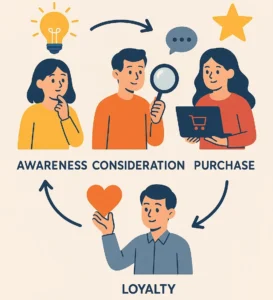The Customer Journey: How to Turn Strangers Into Loyal Buyers Online

Imagine this: someone scrolling late at night, phone lighting up their face.
They pause on your post. Just for a second.
That pause is everything.
In digital marketing, that moment isn’t luck. It’s the first step in something far bigger: the customer journey — the quiet, often invisible path people take from “never heard of you” to “where do I buy?”
If you run a business — whether you sell skincare, consulting, or custom cakes — understanding this journey isn’t optional. It’s the difference between random likes and real sales.
Let’s walk through it together.
1: Awareness — “Who’s this?”
No one buys from a brand they don’t know exists.
At this stage, your audience is barely aware of you — or even that they need what you sell. They’re scrolling, searching, or talking to friends about a problem they haven’t fully defined.
This is where your job isn’t to sell, but to show up.
Think:
• Short videos that answer common questions
• Relatable stories that stop the scroll
• Blog posts explaining everyday problems your product solves
You’re not shouting “buy now.” You’re simply saying, “Hey, we’re here. And we get it.”
2: Interest — “Tell me more.”
Now they’ve seen you. Maybe they’ve visited your profile, liked a post, or clicked a link.
They’re curious. But curiosity fades fast if you don’t feed it.
At this stage, your content should dig deeper:
• Share why your brand exists
• Explain how you help people like them
• Offer quick wins — tips, guides, free downloads
You’re still not asking for money. You’re building trust. You’re answering the silent question in their minds: “Why should I keep paying attention?”
3: Consideration — “Is this right for me?”
Here, they’re comparing. Maybe it’s your brand vs. another. Or maybe it’s “buy now” vs. “maybe later.”
This is where most businesses lose people — not because the product is bad, but because the messaging is flat or unclear.
Don’t panic. Just get real:
• Share reviews and testimonials (real people talking beats any sales copy)
• Answer tough questions openly (price, quality, how it works)
• Show your product or service in action
The goal isn’t to convince everyone. It’s to help the right people say, “Yes, this feels like me.”
4: Action — “I’m in.”
They’re ready. Shopping cart loaded. Credit card out.
Now, the worst thing you can do? Make it complicated.
Keep it smooth:
• Clear buttons that say exactly what happens next (“Book your call,” “Get started now”)
• Fast, mobile-friendly checkout
• Follow-up emails reminding them gently if they stop halfway
At this point, confidence matters more than creativity. People don’t buy when they’re confused — they buy when it feels easy and safe.
5: Loyalty — “I’m staying.”
A sale isn’t the end. It’s barely the middle.
A returning customer is cheaper to keep and more valuable than any new lead.
Show them they matter:
• Thank them (a real thank-you, not just an automated email)
• Offer loyalty discounts or early access
• Share tips on how to get the best from what they bought
This isn’t about squeezing out another sale. It’s about being the brand they brag about to friends.
Why this matters more than ever
The internet is louder than it’s ever been. Everyone’s posting, everyone’s selling.
What sets you apart isn’t a viral video or a clever slogan — it’s how well you understand what your audience feels at every step.
It’s the difference between a brand people scroll past and a brand people remember.
Think about it: when you buy something, it usually isn’t a single ad that convinced you.
It was a slow build of trust. A story. A series of small “yes” moments.
Bringing it back to you
You don’t have to be perfect.
Start by mapping out your customer journey:
• Where do new people first see you?
• What content shows them who you really are?
• How do you help them choose you over others?
• How do you make it easy to buy?
• And finally, how do you make them feel valued afterward?
When you know this, your marketing stops being random. It becomes intentional, human, and — yes far more effective.
Final thought
Behind every click is a person. Someone curious, cautious, hopeful, or skeptical.
If you can see them not just as “traffic” but as real people on a journey — your marketing changes.
And so do your results.
Ready to map your customer journey?
Start today. Your future loyal customers are already out there, just waiting for a brand that truly understands them.
